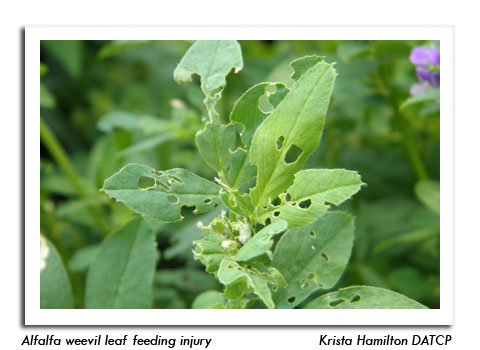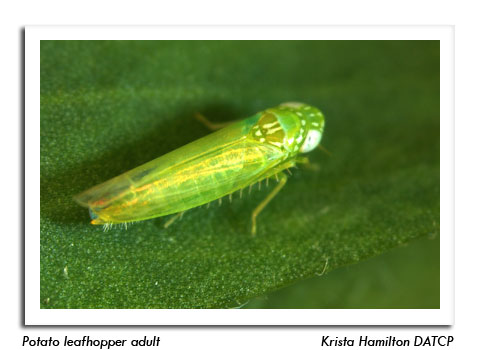
 |
|
|
Forages & Grains
Volume 57 Number 7 Date 05/24/2012 ALFALFA WEEVIL - Larval populations have begun to decline due to pupation and harvest of first crop alfalfa. Some carry-over into second crop regrowth has been observed, but counts are below 3 per sweep and leaf damage is generally less than 20%. Most larvae are in the late instar stages and should pupate by early June. Continued scouting is recommended until the second crop is established or the weevil season has passed. POTATO LEAFHOPPER - Surveys in the southern and east-central areas indicate that levels of this insect remain below established economic thresholds in both the first and second crops. The recent hot weather may change the situation by early to mid-June. PEA APHID - This aphid is the most abundant insect in Wisconsin alfalfa fields. Counts in the southern half of the state range from 2-29 per sweep, with an average of 12 per sweep. The highest population this week was encountered near Reedsburg in Sauk County. MEADOW SPITTLEBUG - Counts rarely exceed 1 per 10 stems. Development has progressed rapidly in past weeks and late instar nymphs are common in many southern and central alfalfa fields. A population of 1 or more nymphs per stem may interfere with harvest operations, but these insects are inconsequential at current levels. Adults should begin collecting in sweep nets by early June. -- Krista Hamilton, DATCP Entomologist WHEAT RUST - Survey observations in 16 wheat fields from Rock to Outagamie counties were made between May 15 and 22. Stripe rust was found in three fields: one in Dodge, one in Winnebago and one in Outagamie County. Crop stages ranged from late boot to flowering complete to top of head, or Feekes 10.1-10.52. Stripe rust infection was generally restricted to the flag leaf, and the incidence was very low in all three fields. Current forecasts for hot and dry weather should restrict any further development of stripe rust in the state. Samples for race identification have been sent to USDA. Other diseases observed were powdery mildew in 13 of 16 fields, with severity ranging from trace levels to 2% of lower leaf surface colonized, tan spot in 10 fields, and barley yellow dwarf virus (BYDV) in three fields. Aphids were present in all fields with BYDV symptoms. -- Adrian Barta, DATCP Pest Survey 




|
|
|